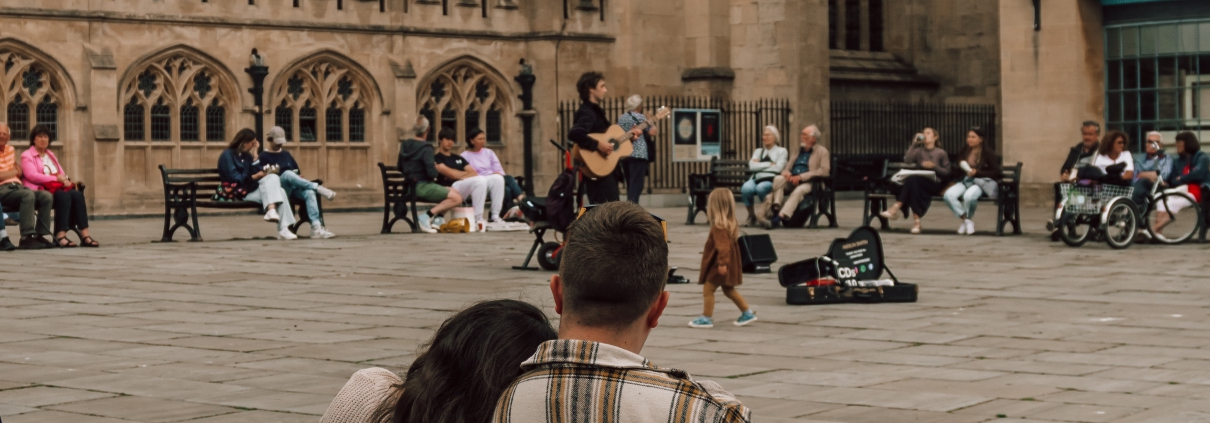Bath’s Buskers: Providing Life to a Historic City
Hopping on a bus on Sunday morning, I made the three-hour journey to Bath, England. As I left the Bath station, I was immediately immersed into the quiet bustle of people strolling through the city’s cobblestone and tile streets on a rainy morning.
The light grey clouds and occasional drizzle was a fitting forecast for the calm richness of Bath.
It was amusing to observe how each person was enjoying the city in their own way. Whether it was grabbing a pint in a pub, enjoying a coffee at a quaint café or strolling through the many shops, Bath held something valuable for anyone. But many were exploring the historical wonders such as the Roman Baths, Bath Abbey or watching the river flow from Putney Bridge.
Because the city centre lies within a valley, long rows of honey-coloured houses snake throughout the hills on its outskirts. Each with its many chimneys jutting out paired with white windowsills. The greenery along every hill stands vibrantly against the rigid stone buildings.
Bath appears as though it has been frozen in time since its transformation from the Roman province, Aquae Sulis, to what is today known as Bath during the Georgian period in the 18th century. The Bath stone, an oolitic limestone, gives the buildings its distinctive colouring. One can feel the culture and history that has been preserved for so long.
I had the pleasure of walking through the high arches of Bath Abbey, a church that has been used as a Christian place of worship since the 12th century. The immense, colourful stained glass windows, the oldest dating back to 1603, depict the life of Jesus Christ, stories from the Bible and the crowning of King Edgar. While every feature in the cathedral stood still, I could observe its complex structure like it was its own living organism.
I was quite surprised to be spending much of my day, though, observing the many buskers scattered throughout the streets. The musical skill of each performer was astounding, and the range of instruments being played allowed you to walk through the streets hearing different styles of music.
As I first entered the city’s centre, I came across a pianist who was travelling Europe with a piano painted colourfully and adorned with sticky note messages written by passersby. The pianist, who I later found out is named Jonas, played emotional renditions of various well-known songs. In front of his instrument was a sign that read that this has been the 26th country he has played at.
Before I could see it, I could hear the soothing tone of a trumpet echoing off the beige stone buildings. Continuing further through the winding alleys, I came across the trumpeter, Ivan Andre playing with a tone and vibrato so soothing it made the many pedestrians stop to listen beside Bath Abbey. His beautiful runs sounded as though they were emanating from the building walls themselves.
At the front of Bath Abbey was a violinist playing soothing classical music, and just a couple of hours later, a young guitarist and drummer duo took his place, jamming out in their performance of “Hit the Road Jack” by Ray Charles.
I eventually wandered in front of the “Fiddler on the Rope,” otherwise known as Kwabana Lindsay. An international circus performer, Lindsay effortlessly played the fiddle whilst walking across a slack rope suspended five feet in the air.
These performances further enhanced my own experience visiting Bath by not only providing entertainment whilst exploring, but deepening the cultural richness of a city frozen in time.
Street performing, or busking, dates back to ancient Rome during agricultural and religious festivals when two parties “would hurl insults in a sing-songy manner.” It was also used to celebrate the working class and supported by the Roman government. Once Rome fell, though, busking was essentially cast out as free speech was restricted. Even after the Church of England deemed busking sinful, it was used as a tool to instil social change, protest injustice and transport creative ideas and songs amongst regions.
In 2014, a dispute between Bath Abbey and buskers had been persisting for months and erupted when “a choral evensong service was halted because the buskers could be heard above the sound of the Bible reading and threatened to disrupt the choir,” according to The Guardian article.
While the rector of Bath Abbey claimed that buskers using amplifiers near the church were disruptive, performers claimed that the church was trying to restrict their freedom to play to the public.
It is not up to me to decide who is at fault, but it is undeniable that the very essence of busking was reignited as a medium for combatting injustice.
The historical architecture preserved for centuries was breathtaking enough to look at, but the buskers provided this ancestral city a breadth of newness and life. Their skillful craft gives the city a new, young heartbeat energising artistry and creativity.
Bath is a shining example of how street performers help enhance the culture of a city that has been around for centuries and can be used as a medium to communicate ideas and emotions.





